Menu
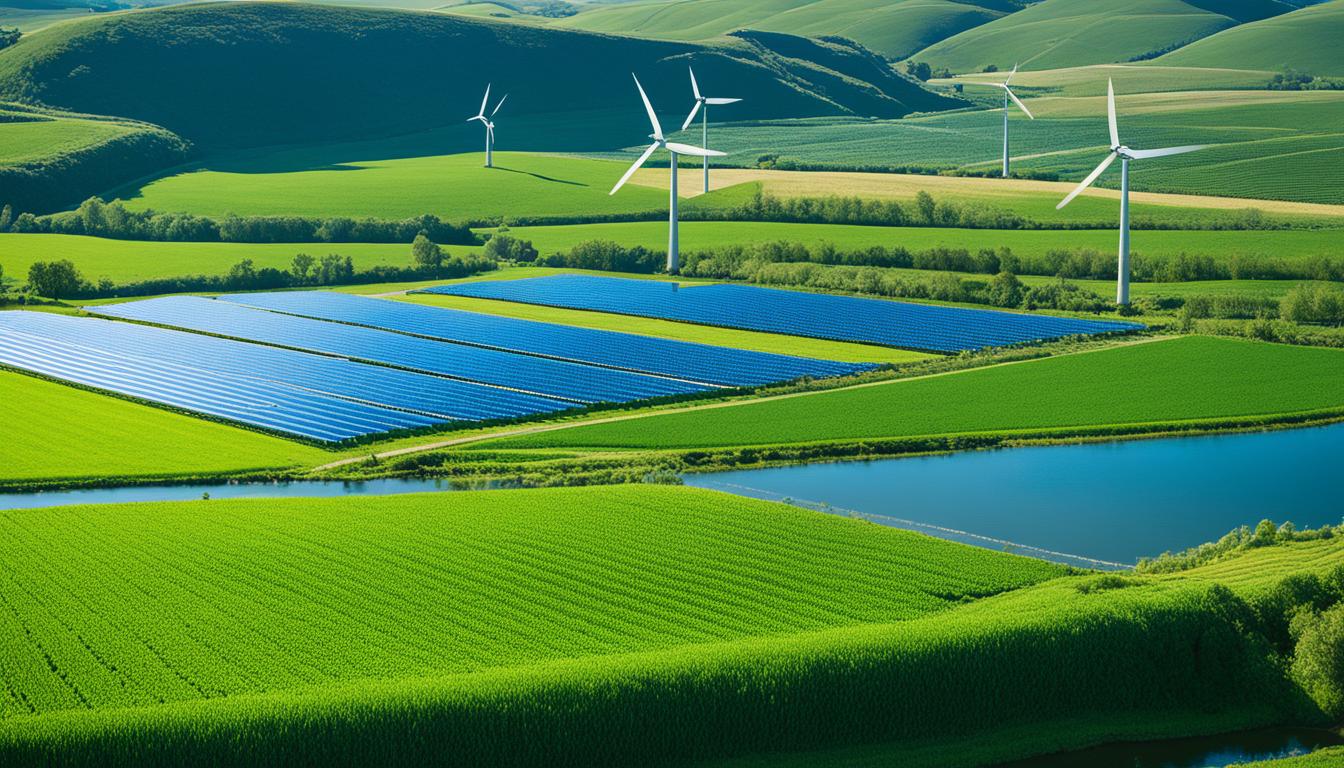
Food production is a big player in making our world warmer. It’s responsible for about 26% of the greenhouse gases we release each year. To combat this, farmers have a key role to play. They strive to keep our planet safe for future generations while still providing good-quality food. Cattle producers, for example, are at the forefront of this effort. They use Best Management Practices (BMPs) to farm in ways that are better for our Earth. These practices include keeping an eye on how many animals they have and how they handle manure.
Farmers do a lot to reduce their negative environmental impact. For example, they keep animals away from streams and rivers, don’t plough up the soil more than necessary, and make sure animals eat grass in a way that helps the land. All these steps are crucial for farming that is kind to the planet.
Farmers also make clever use of manure. It’s full of nutrients that help crops grow well and keeps the soil healthy. Laws, like one called Article 25-AA, give farmers a hand, encouraging them to keep farming. Conservation planning, run by the Natural Resources Conservation Service (NRCS), is also a big help. They offer advice and money to farmers who want to protect their land for the long term. These efforts aim to balance farming with nature, keeping both farmers and the environment happy.
Looking into how farming affects the environment is crucial. There’s a fine balance between farming and keeping our planet healthy. This balance must be managed carefully to lessen harm.
Agriculture plays a big role in damaging our environment. It needs a lot of water and causes forests to disappear. In 2016, over 700 million hectares grew staple cereal grains. This shows how much land farming uses. In the western United States, livestock graze on hundreds of millions of acres, hurting the soil even more.
Also, chemicals used in farming have increased the amount of harmful nitrogen by up to 600%. This pollution leads to water and soil problems. Too much nitrogen and phosphorus cause deadly algal blooms in the water.
Farming can harm our water and air, so we need special rules. The use of fertilisers is a big part of the gases that heat up our planet. So, these downsides show why we need to farm in ways that protect our environment.
There are many ways we can lessen the bad effects of farming. Some programmes pay farmers to use their land less. Such actions help nature. Laws like the Clean Water Act make sure that pollution in water is controlled. Teaching farmers about better methods and giving them certifications can also help. For example, being certified as Organic means following practices that are good for the earth.
| Impact | Statistic |
|---|---|
| Freshwater Consumption | 70% of global usage |
| Cereal Grain Cultivation | 700 million hectares (2016) |
| Reactive Nitrogen Increase | Up to 600% |
| Ocean and Freshwater Eutrophication | 78% caused by agriculture |
| Food Production Emissions | 26% of global greenhouse gases |
| Livestock Non-Human Biomass | 94% |
| Deforestation Caused by Agriculture | 80% |
To enforce eco-friendly rules in farming, a mix of learning support and bonuses is key. Helping farmers learn and offering cash rewards aids in ensuring they use sustainable methods. This way, we solve environmental issues together.
Tackling farming’s impact on the environment starts with teaching. This teaching can be from handing out booklets to one-to-one advice, all in the name of keeping farmers smart about cutting-edge methods. Groups like the USDA offer top-notch help and easy access to info.
Seeing is believing. Projects that prove the worth of green farming are eye-openers. They show others how it’s done, helping the whole industry move towards a greener future.
Rewarding farmers for being Earth’s friends is also crucial. By offering money and other perks to those who farm sustainably, we drive change. Programs like the Environmental Quality Incentives Program lighten the load of going green.
There’s also help for farmers willing to stop growing crops on certain lands. The Conservation Reserve Program pays these farmers to keep their land crop-free for a decade. This helps the environment and lowers the harmful stuff being let out into the world.
One more thing farmers can do is join trade programs to cut pollution. They earn rewards for lowering their impact, which makes being green both good for the planet and their wallet.
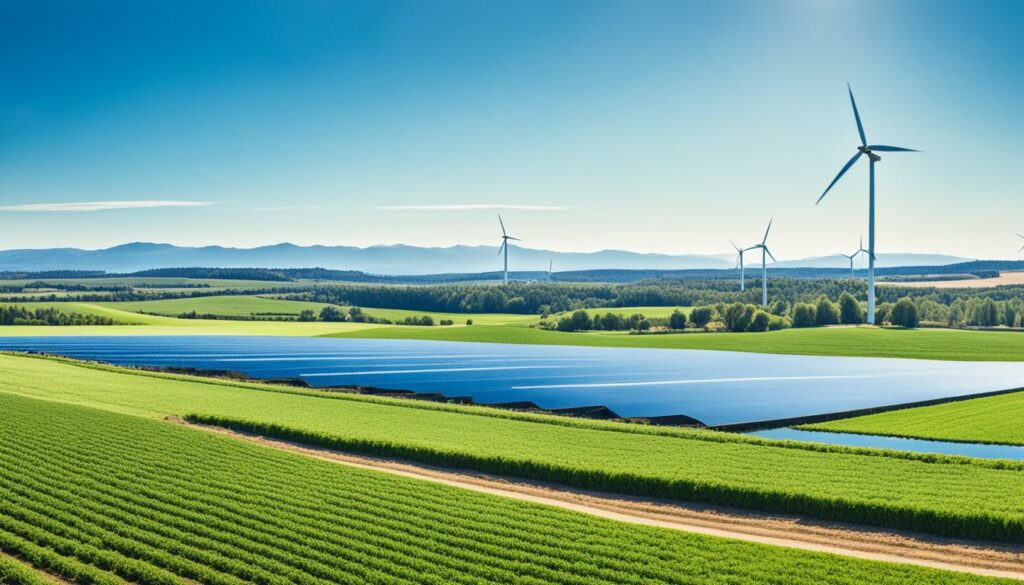
Maintaining soil health is key in farming that lasts. Strategies like composting and using cover crops help a lot. They keep the soil in good shape and full of nutrients. Manure, when used as fertiliser, makes sure plants get what they need to grow strong.
Cover crops and green manure also boost the soil’s health. They make the soil richer in organic matter. This helps create a thriving environment underground.
Composting is important for reusing organic rubbish. It keeps the soil from getting polluted by waste. Plus, using composted manure is a way to feed the soil well. This method helps keep the earth healthy, reducing the need to disturb the soil, which is good for the planet.
Planting cover crops helps keep the soil together and stops weeds. They’re especially good when it rains a lot. They soak up the water and keep the ground from washing away.
Legumes in these crops are very helpful. They naturally add nitrogen to the soil. This slowly feeds the plants. Mixing these cover crops in with the main crops also helps wildlife.
This mix of approaches helps farming stay productive and healthy. It also deals with issues like the soil getting worse and protecting the environment.
It’s vital to manage water well in farming for the sake of the environment and agriculture’s future. As a big water user, the US farm sector needs a close look at how it uses and saves water. Good water management can greatly boost farm water quality.
Recently, 40 groups came together for 15 sessions on water in the US. They talked about water use with over 500 leaders, from water managers to farmers. Such discussions help people from different fields work together, which is key for solving water issues.
Farm run-off is a top cause of water pollution in the U.S. Today, more than 100 farmers are part of programs that help keep both city and farming areas clean. This is done by using smart water practices, like better irrigation and reusing water. These methods can shrink the amount of water farms need.
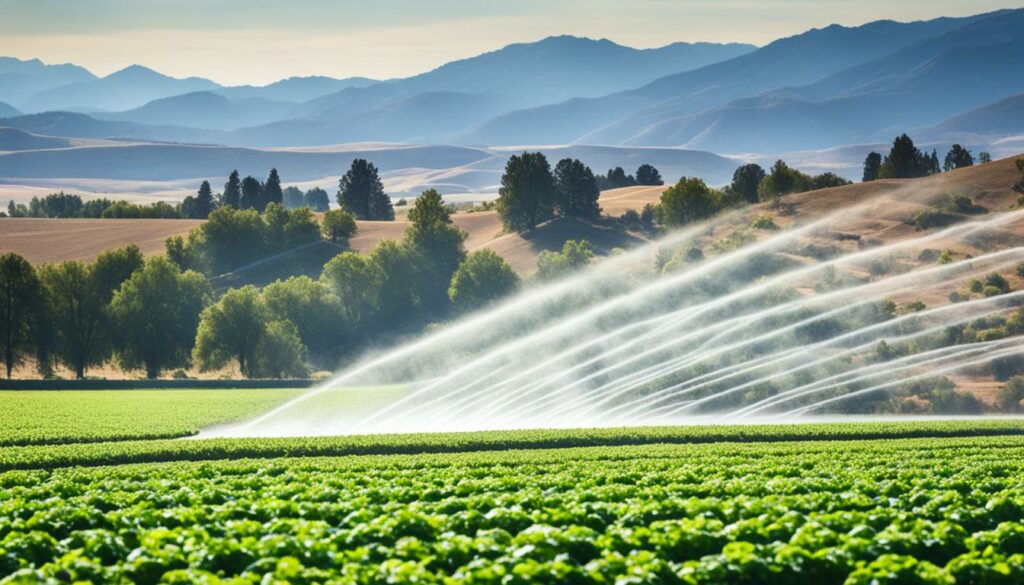
The USGS has begun a special water monitoring project in the Silver Creek area. Covering 4,800 acres, it includes farmers and experts working to cut pollution. Their aim is to prove that the right farming practices can make water cleaner.
Looking at the Chesapeake Bay area, where farms are big, we see how conservation helps. Nearly 30% of its land is for farming. Across 2018 to 2020, the NRCS helped farmers to use green methods on 1.26 million acres. This is as big as the Grand Canyon National Park.
Also, bigger projects like the NWQI have made over 16 unpolluted water bodies cleaner. In the Mississippi River area, efforts increased the use of good farming practices by 30%. These include using cover crops and less tilling. Such teamwork is crucial for success.
| Program | Impact |
|---|---|
| One Water for America | Engaged over 500 leaders to improve water management strategies. |
| Silver Creek Watershed Project | Focused on phosphorus reduction through collaborative efforts. |
| Chesapeake Bay Watershed Conservation | Implemented conservation on 1.26 million acres of farmland. |
| National Water Quality Initiative | Enhanced 16 impaired water bodies, leading to successful water quality improvements. |
Water management is key for our world’s health. By using smart water ways in farming, we can make big changes. This keeps water clean for farming and nature.
Introducing eco-friendly farming methods is key for lasting success in agriculture. These methods increase productivity and safeguard our natural world. Mulching is one valuable technique. It boosts soil health and increases crop outputs.
Mulching is good for farms as it keeps soil temperature even, holds moisture, and stops weeds. This way of farming helps save water and betters the soil. By cooling the soil, mulching helps roots grow well, leading to healthier plants. It also means less lost water, saving on water use and money.
The farming sector, which earns $1.3 trillion yearly, benefits greatly from mulching. It saves water and improves the soil, critical for the 50% of land used for growing food. This includes croplands and pastures.
Biological pest control is another big deal for eco-friendly farming. It means using natural enemies to fight off pests. This reduces the need for chemicals. It helps keep the ecosystem balanced and the farms healthy for years. So, it cuts down on the dangers of pesticides and promotes farm life variety.
Using natural pest control over chemicals is great for the Earth. It’s a step towards greener farming. It matches the industry’s push for cleaner agriculture, which includes less pollution and more biodiversity.
European studies on organic and no-till farming show great results. They increased the amount of carbon in the soil. Adding cover crops also helps keep soil rich and stops it from washing away. These techniques not only boost farming but also help keep our planet green.
Agri-environmental policies are key in getting farmers to meet green goals. They are a mix of rules and choices that help farming be greener. This includes following laws to take care of the land while farming.
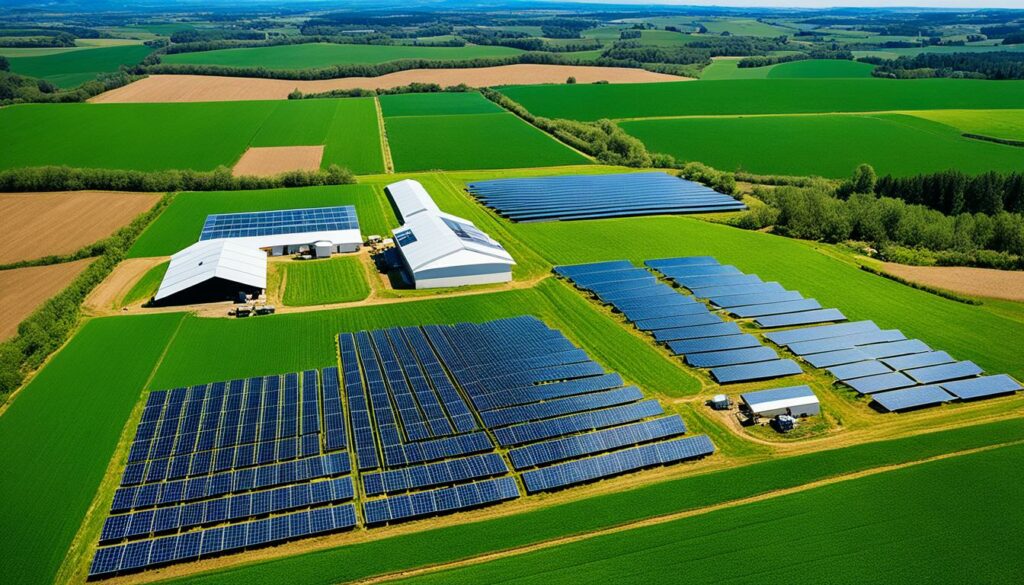
These policies have really cut back on harming the environment. For example, the U.S. saw big drops in soil erosion between 1982 and 1997. A big part of this came from making farmers follow certain rules. Rules like protecting easy-to-erode lands did a lot to lessen damage.
These rules also help with big issues like nutrient runoff. Paying farmers to take care of the land has been a smart move. It has made doing good for the land make financial sense for farmers. This money made a big difference, even on lands that aren’t seen as easily eroded.
The OECD, a global group, has been key in setting up these green rules. Back in 2011, they talked about the best ways to make policies work in Germany. They now have suggestions to help countries pick the right policies. A decent number of countries, 20 plus Estonia, are using these payment plans to help farmers.
Tying payments to how well farmers protect the environment has been a big success. This beats just using laws. It pushes farmers to keep up with high environmental standards. It shows us that the right green policies and rules are really vital for farming that lasts.
In the future, using green policies well is going to be key for farming better. Making these policies clear is important. It helps farmers get why they need to care for the land. This, in turn, leads to farms that are better for our planet.
Organic farming rules are critical for sustainable agriculture. They provide a solid plan for creating eco-friendly farm products. To meet them, farmland must go three years without certain chemicals before crops are grown. This rule makes sure the soil and plants are pure, without artificial pesticides or fertilizers. This process helps keep the environment healthy.
When it comes to animals, farmers must give them 100 percent organic food. They can add some vitamins and minerals. This helps make sure the animals and their products are truly organic. Ruminant animals, such as cows, must spend 120 days on pasture, eating at least 30 percent of their food from the fields. This rule helps animals have a natural diet.
Getting organic certification confirms that farms are following these good practices. It helps shoppers know their food comes from sustainable sources. For a product to be labelled as organic, it must be at least 95 percent organic. If something is marked as “made with” organic ingredients, it must be 70 percent organic. This difference helps customers choose products that meet their eco-friendly standards.
The USDA and other government bodies set these important rules. They guide farmers in choosing sustainable methods. Following these rules helps farmers stand out in the market. When a product is certified organic, it shows it’s good for the environment. It can also sell for a higher price. This supports both the planet and the farmers that work hard to meet organic standards.
Below is a table with some key rules for organic farming:
| Regulation | Requirement |
|---|---|
| No Prohibited Substances | Applied for at least 3 years before harvest |
| Livestock Feed | 100 percent organic with allowed supplements |
| Ruminant Grazing | 120 days minimum on pasture, 30 percent DMI from pasture |
| Certified Organic Products | At least 95 percent organic content |
| “Made with” Organic Products | At least 70 percent organic content |
Understanding and following these rules lets farmers get organic certification. This means they can label their products as eco-friendly. It plays a big part in making agriculture sustainable. For deeper information and standards, it’s best to check out the USDA Organic Standards at organic certification guidelines.
Today, managing farm waste well is key to lessening environmental impact. It helps farms run sustainably. But, small and mid-sized farms face challenges in this area. They deal with small budgets, limited space, and the need to follow environmental laws. Yet, using the right methods can help them reduce waste and create circular farming systems.
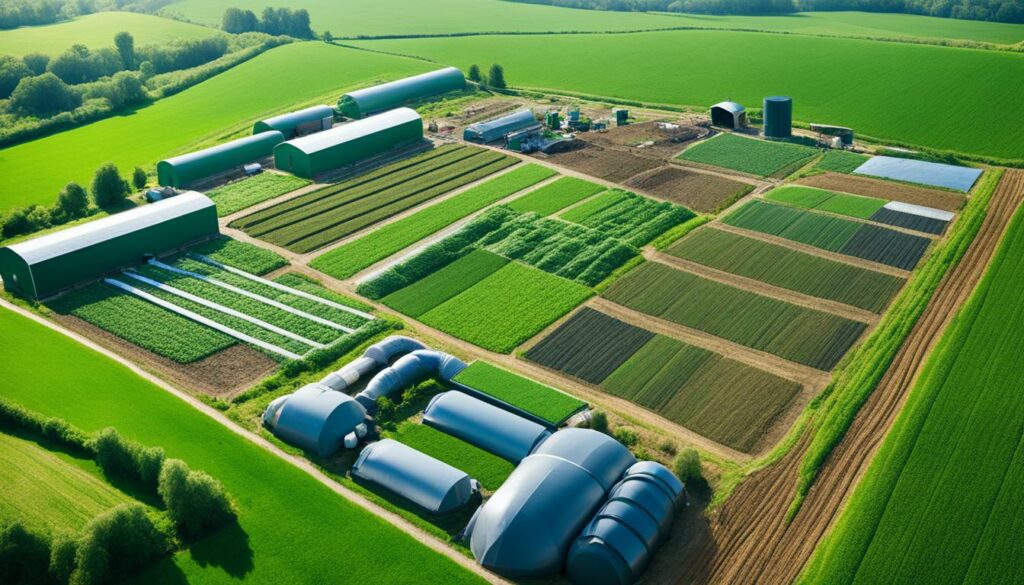
Farmers use a lot of plastic, like mulch films and greenhouse covers. This adds to waste on farms. By recycling, farms can cut down on sending plastics to landfills. Also, recycling lowers the carbon footprint of farming. Thanks to more collection and recycling efforts, farm waste could drop by 20%. This is good news for the environment.
Turning bad fruits and vegetables into compost is a smart move for farms. About 1.2 billion tonnes of food waste is thrown out by farms each year. Composting turns this waste into something useful for the soil. It makes about 80% of farm waste into something valuable. Good composting means less to throw away. It lowers costs and boosts profits by up to 15%. Also, it’s a win for the planet, cutting farms’ carbon footprints by 25%.
| Waste Management Strategy | Environmental Impact Reduction | Cost Savings | Profit Increase |
|---|---|---|---|
| Recycling Agricultural Plastics | 20% reduction in waste output | Up to 50% in waste management expenses | Increases due to reduced input costs |
| Composting Agricultural Waste | 70% reduction in environmental harm | Lower disposal costs | 15% increase through improved soil health |
Adopting these waste management strategies helps in two big ways. It improves the environment and the economy. This makes farms more sustainable and profitable in the long term.
I support protecting farmlands, and conservation easement programmes play a big part in this. They give landowners money to keep their lands as farms. This stops the lands from being used for other things and helps the environment.
It’s crucial to follow sustainable agriculture guidelines. They help protect the environment and keep farms productive. Farmers must use methods that balance growing crops and raising animals.
Keeping a good crop and livestock balance is key in sustainable farming. Mixing crops and animals well can make a farm 15% more productive. This not only makes the soil healthier but also helps against ups and downs in the market or weather.
Growing cover crops in the off-season is a great idea. It stops the ground from washing away and makes the land better. It also means less money needs to be spent on fertilisers. These actions show how mixing different farm jobs can help the whole area stay healthy.
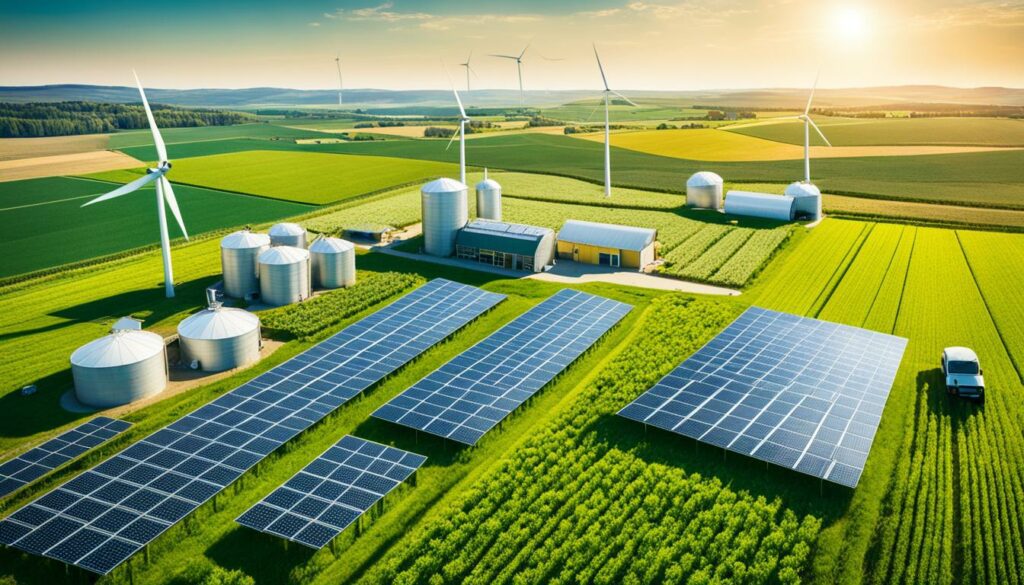
Rotational grazing has many benefits for sustainable farming. It means moving animals between different fields from time to time. This stops the fields from being overeaten and helps them grow back. Research has found that this approach boosts the variety of plant and animal life and makes the soil healthier naturally.
This type of grazing is also good for the land. It makes the fields stronger so they can handle changes in the weather. By making the soil better and preventing it from washing away, this method supports farming that can last and keeps the environment stable.
| Practice | Benefit | Statistic |
|---|---|---|
| Planting Cover Crops | Reduces Soil Erosion | 30% Reduction |
| Rotational Grazing | Enhanced Biodiversity | Supports Grassland Ecosystems |
| Integrated Crop-Livestock Systems | Increased Farm Productivity | 15% Increase |
These practices are vital for the future of farming. They show how to mix different aspects, like growing crops and using animals, in a good way. Crafting wise grazing strategies is essential for farming that’s both effective and kind to the earth.
Renewable energy is a key solution for farms facing energy challenges. By using biogas and solar power, farms can be more efficient and eco-friendly. These methods help reduce harm to the planet.
Turning waste into biogas is a great chance for farmers. They can use animal manure and leftover crops to make energy. This energy can power farm machinery or heat buildings.
By choosing biogas over traditional methods, they help cut methane gases. This is good for the environment. Also, using biogas could bring more money into local farming areas. The U.S. Department of Energy says up to $20 billion could be added.
Solar panels are changing how water is managed on farms. They can power pumps for watering crops. This means less need for electricity from the main grid. It also cuts down on power costs.
This is very useful in places far from cities. Bringing electricity there is often too expensive. The government is supporting solar with tax credits and grants for farmers. Solar power makes farming more eco-friendly. It also helps use water more wisely.
Supporting a mix of production and green goals is crucial. It helps farmers make more food in a way that’s good for nature. This approach pays off economically for those who grow the food.
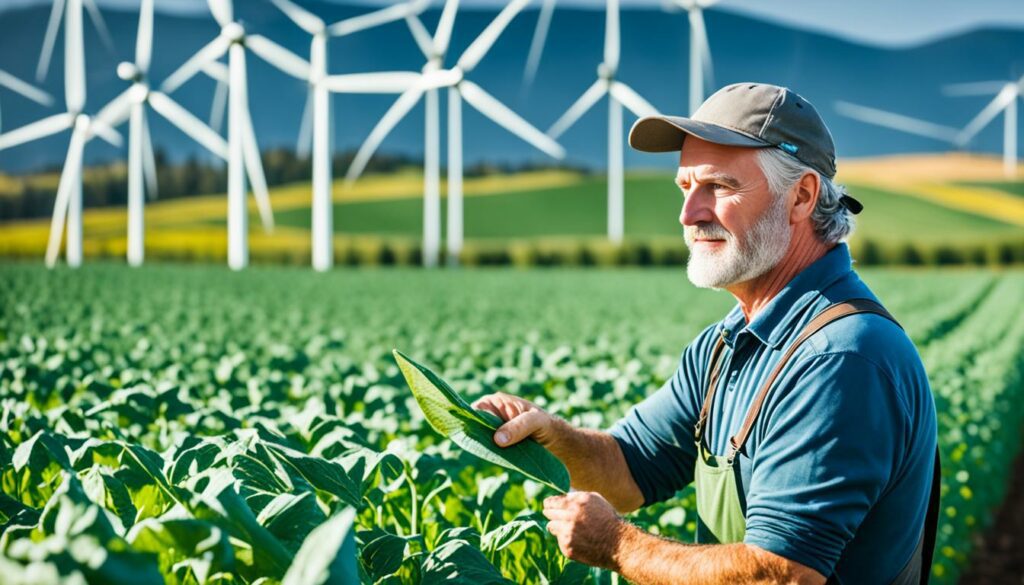
Sustainable farming is good for the planet and a farmer’s wallet. It cuts costs by using organic fertilisers and a careful type of farming. This means farmers make more money and the earth is healthier. The UN Food and Agriculture Organisation says these methods could make global harvests 20% bigger. At the same time, they help cut down on pollution and save water.
Farming for the future means keeping our soil strong. Methods like planting different crops each year and farming without disturbing the soil too much are key. These tricks boost the soil and keep it from getting sick. They also mean less need for harmful chemicals. Plus, this way of farming protects the land, keeps water in the soil, stops the soil from washing away, and cuts down on a gas that harms our air.
| Practice | Benefits |
|---|---|
| Crop Rotation | Manages pests and diseases, enhances nutrient availability, and reduces dependency on chemical pesticides. |
| Conservation Tillage | Improves soil health, moisture retention, erosion prevention, and reduces carbon dioxide emissions. |
| Agroforestry | Increases crop yields, livestock productivity, soil conservation, water retention, and carbon storage. |
| Integrated Pest Management (IPM) | Reduces usage of synthetic pesticides and promotes ecologically friendly pest management techniques. |
Spending on making soil better is smart for the world and for the money. Healthy soil means less need for man-made stuff, pulls pollution from the air, and grows better food. This way, we can keep farming going strong, safe for the world, and ready for our kids.
This helps find a way to make enough food now and later, without hurting the planet.
In today’s world, moving towards sustainable farming is key. The EPA and USDA watch over environmental rules in farming. Though farms and ranches often had special treatment, this is changing. The effect of farming on the earth is clear. This means more oversight is needed.
Getting to grips with green rules in farming is crucial. The EPA’s new steps on cutting farm pollution spark debate. Permissions are vital, especially for big farms. The USDA backs this by pushing for greener farming with benefits. This improves both the planet and farming.
Exceeding green standards is more than a must; it’s a mindset. Farmers should go beyond rules, using systems like ISO 14001. These help with waste and farm nutrient needs. Doing better not only helps nature but also boosts farming’s image and strength.
Help farmers by teaching them through education and giving them technical help. Use incentives and rules to make farms more eco-friendly. Make sure farms keep getting better at meeting environmental aims.
Farms can harm the environment. For example, using too much fertiliser can pollute water. Bad waste management can also contaminate air and soil.
To solve problems, farmers can join educational schemes and get incentives. They must also follow some rules. For instance, they need a permit to put waste in water under the Clean Water Act.
Educational help and new knowledge make it easier for farmers to do the right thing. By learning how to farm better, they can protect the environment.
The Environmental Quality Incentives Program helps farmers. It gives them money to use better ways of farming. This makes their farms better for the environment.
Composting and managing manure puts important chemicals back in the ground. This helps crops grow strong and makes the soil better for farming.
Cover crops and green manure are important in farming that protects nature. They keep soil from washing away, add to the ground, and stop soil erosion. This helps farming last a long time.
Good water use includes planning well, reusing water, and having smart ways to water plants. It’s also important to keep water clean and safe from farming waste.
Mulching keeps soil at a good temperature, holds water, stops weeds, and helps soil life stay healthy. This all means using less water and having strong, rich soil.
Using natural helpers to control bugs means less need for harsh chemicals. This is better for the environment and safer for us.
These rules and ways to follow them aim to make farms kinder to nature. They want farmers to help protect the environment in ways that work for everyone.
Organic rules say how to farm without some chemicals. Being organic tells buyers the food is good for the earth. This often means farmers can sell their food for more money.
Good waste handling includes using old plastics again, turning bad food into compost, and finding new jobs for what’s left over. This makes less mess and helps the environment.
These plans give money to farmers who promise not to use their land in some ways. This keeps the land good for crops or nature.
To farm in a way that lasts, use both crops and animals together smartly. For example, let animals graze in different fields to help the land and animals stay healthy.
One way is by making biogas from farm waste. Another is by using the sun to power water systems. These methods are clean and smart.
Doing sustainable farming can cost less and make more. It can open new markets for farmers, helping them and the land keep going strong.
To be environmentally safe, farmers must know and follow laws. They need permits and should always try to do better than what’s asked.